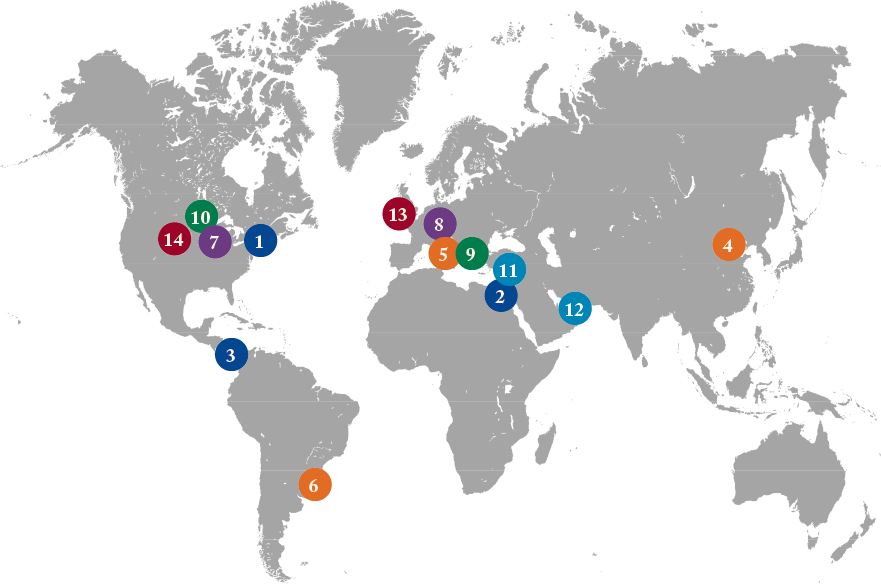Canals
(1) Erie Canal, 1825
Built by Benjamin Wright and his corps of self-taught engineers, the state-funded canal reduces the cost of transporting products from Buffalo to NYC from $100 a ton to less than $10.
(2) Suez Canal, 1869
The first canal to provide a direct sea route between the Mediterranean and the Indian Ocean is built in 1850 bc but later filled in by Abbasid caliphs. In the modern Suez Canal’s first year, fewer than two ships pass through each day; by 1966 the number is up to around 58 ships per day.
(3) Panama Canal, 1914
After a failed French attempt to construct a sea-level canal between Colón and Balboa, the U.S. pays $40 million to take over the project. The earth and rubble removed would be sufficient to bury the island of Manhattan to a depth of 12 feet.
Bridges
(4) Anji Bridge, 605
Built to expedite the movement of goods by land in the North China Plain as part of the Sui dynasty’s public works, the oldest open spandrel bridge in the world has remained in continuous use.
(5) Ponte Vecchio, 1345
The first bridge across the Arno dates to Roman times, as part of the Via Cassia. The Ponte Vecchio is later built on the same spot in Florence. In 1593 Ferdinand I decrees that the only vendors allowed on it are jewelers and goldsmiths.
(6) Baron of Mauá International Bridge, 1930
As part of a 1918 treaty, Uruguay agrees to build a bridge across the Rio Jaguarão and to name it after the greatest Brazilian industrialist of the nineteenth century, Irineu Evangelista de Sousa. The same site hosted an 1865 battle between Uruguay and Brazil.
Tunnels
(7) Underground Freight Tunnel, 1903
A sixty-mile-long narrow-gauge railroad carries freight and mail forty feet below downtown Chicago. Construction begins covertly in the basement of a saloon in the Loop, with workmen passing through in the guise of patrons and earth removed by carts after the saloon closes at midnight.
(8) Simplon Tunnel, 1906
It takes three thousand workers to dig a twelve-mile tunnel 4,500 feet below the Lepontine Alps connecting Switzerland and Italy. For many years it is the longest tunnel in the world, allowing direct train service between Paris and Milan.
Portages
(9) Diolkos, c. 600 bc
A limestone-paved trackway across the Isthmus of Corinth enables Greek merchant ships to avoid the perilous journey around the Peloponnese; dragging a boat across it takes three hours. During his reign Nero tries to dig a waterway through the isthmus, but the canal remains incomplete until 1893.
(10) Grand Portage, 1729
Connecting Lake Superior with the Pigeon River, this nine-mile-long portage allows voyageurs and Ojibwa to trade from Lake Winnipeg and the Hudson Bay to the Great Lakes. The North West Company builds its inland headquarters here; the post remains active until 1802.
Harbors
(11) Sebastos Harbor, c. 15 bc
King Herod builds a concrete harbor along the Mediterranean coast of Judea using pozzolana for the underwater construction of hydraulic concrete. Due to treacherous currents, Herod’s engineers construct two breakwaters and a lighthouse. Saint Peter baptizes the first recorded gentile convert to Christianity here.
(12) Jabal Ali, 1979
Built by Sheikh Rashid as the centerpiece of Dubai’s commercial development, the world’s largest man-made harbor is dredged from soft rock on the ocean floor of the Persian Gulf.
Railroads
(13) Penydarren Tramroad, 1804
The first steam-engine locomotive hauls ten tons of iron, seventy men, and five wagons from the Welsh Penydarren Ironworks to the village of Abercynon; it takes two hours to complete the nine-mile trip.
(14) Bailey Yard, 1867
The world’s largest railroad classification yard, in North Platte, Nebraska, has 17 arrival and 16 departure tracks that handle 14,000 railcars a day. Three thousand cars are sorted daily in the hump yards.
